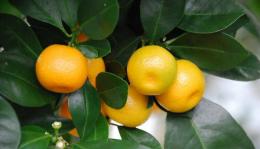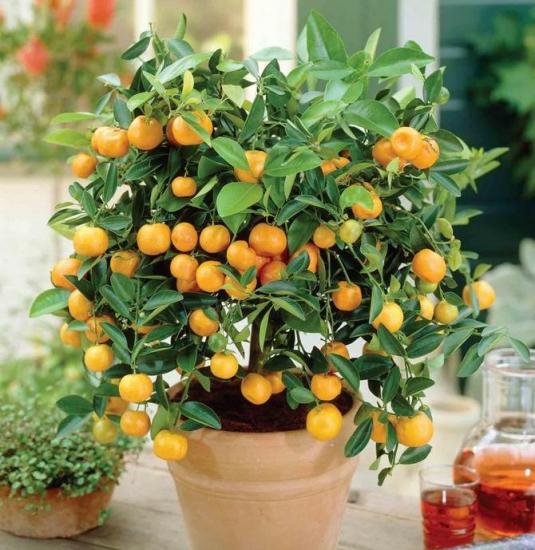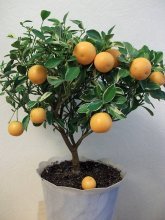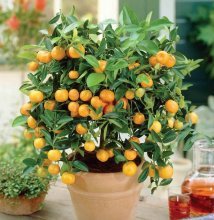Calamondin: plant propagation at home

Plants from the Citrus genus have always attracted people with their beneficial fruits and decorative appearance. In addition, they were quite easy to grow by planting a seed from an eaten fruit in the ground. It is clear that under indoor conditions, fruits on such a seedling did not appear for decades.
However, over time they were withdrawn varieties and hybrids of citrus plants that flower and fruit when grown in pots. Calamondin, the propagation of which is available to amateur gardeners, is one of the citrus crops that can be grown in pots to produce fruit.
Content:
- What is calamondin and can it be propagated independently?
- Reproduction of calamondin by cuttings
- Reproduction by grafting
What is calamondin and can it be propagated independently?
Calamondin is a representative of the Citrus genus of the Rutaceae family. The plant was obtained as a result of hybridization of mandarin with fortunella. In another way, its name sounds like it is composed of the names of plants of the parent forms - citrofortunella. From the genus Fortunella, the kumquat plant was involved in the production of the hybrid.
Citrofortunella, like kumquat, is most likely of Chinese origin. From where it came to other regions of Asia, Europe and the USA. The life form of calamondin is an evergreen low tree with good branching. In potted culture it can grow up to 2 meters in height, and in open ground - up to 5 m.
The leaves are medium-sized, smooth, dark green, shiny.They have a pleasant citrus aroma. The flowers are white and smell very good. The fruits are small, weighing 13-15 grams and up to 30 mm in diameter. They are more like miniature tangerines, as they have a slightly flattened shape and from 6 to 10 segments under a thin peel. The lobules themselves are separated by a thin transparent film.

The thickness of the peel is no more than 1.5 mm. Like tangerine the peel is easily removed from the pulp. The peel is edible, with a sweet taste. This plant is similar to a kumquat. Fresh fruits, like kumquat fruits, are eaten with the peel. The taste of the pulp is sour or strongly sour.
The plant is popular in indoor floriculture, as it looks simply gorgeous with orange fruits and white star flowers, which can be on the same plant at the same time. Calamondin is widely used for landscaping residential and office premises, for growing in winter gardens and greenhouses.
A large number of seeds can be found in the calamondin pulp. However, seed propagation of this crop is used extremely rarely. After all, the plant is practically an intergeneric hybrid; grown from a seed, it may never bloom or bear fruit. At the very least, you need to wait a couple of five years for flowering. In this case, the meaning of growing this citrus crop is lost. Therefore, the most acceptable methods of reproduction for this calamondin are:
Reproduction of calamondin by cuttings
Best time for reproduction cuttings in a temperate climate - this is mid-summer. It is during this period that it is easiest to create the necessary temperature conditions for cuttings for rooting. It successfully takes place at + 25 + 26 degrees. For propagation, apical cuttings with three to four leaves are used.
Cut the cuttings with an oblique cut. The cut is dried in air for several hours. After this, it is treated with any growth stimulant. You can simply soak the cuttings in an epin solution for 10 hours. After this, the plant is planted in loose soil and covered with a jar.
This greenhouse is placed in good, but not direct sunlight.
It is important to ensure that the temperature does not fall below 25 degrees. Otherwise, the process of root formation will begin, and the cutting itself will simply die. During the day, the cuttings should be opened for ventilation for 30 to 40 minutes. When the soil dries out, watering is carried out, and phytohormones can also be used.
If all conditions are met, after three weeks the roots will begin to grow. Calamondin obtained from cuttings will begin to bloom and bear fruit in the third or fourth year. Given the low survival rate, you need to root several at once. Cherenkov.
Reproduction by grafting
Propagation by grafting involves the participation of two plants. The first will act as a rootstock. For these purposes, it is convenient to use young orange seedlings. The grafting material - scion - will be harvested from the second plant. For this you need an adult calamondin. A small stalk is cut from it.
Video review of calamondin:
To carry out grafting, you can use the “bark” grafting technique. The best time for vaccination is spring - mid-summer. To do this, the rootstock is cut at a height of 10 - 15 cm. Use a sharp knife to push the bark away from one side. The end of the cutting is cut so that an oblique cut 20 - 30 mm long is obtained. With this side, the cutting is tucked behind the bark and secured with adhesive tape, wrapping it around the graft with the smooth, non-sticky side.
The grafted plant is covered with a bag or plastic bottle and placed in a warm place. After a month, the protective covering is removed, and after another 5-6 weeks, the adhesive tape can be removed. To do this, it is not necessary to unwind it. You can make a neat vertical cut along the entire length of the winding.
As it grows, the trunk will increase its diameter and get rid of the tape itself.
In the future, caring for the plant consists of timely watering, feeding and transplants as they master the pot. If everything was successful and calamondin began to bear fruit, its fruits are used:
- fresh
- for making sauces
- jams are made from them
- used for homemade candied fruits

Thus, citrofortunella or calamondin is not only a beautiful plant, but also useful.











Comments
A very beautiful citrus plant. We tried to grow a lemon from a seed; we had a tree for 10 years, but it never bloomed and soon died. If we had grafted calamondin onto it, then we would have had a citrus harvest a long time ago.